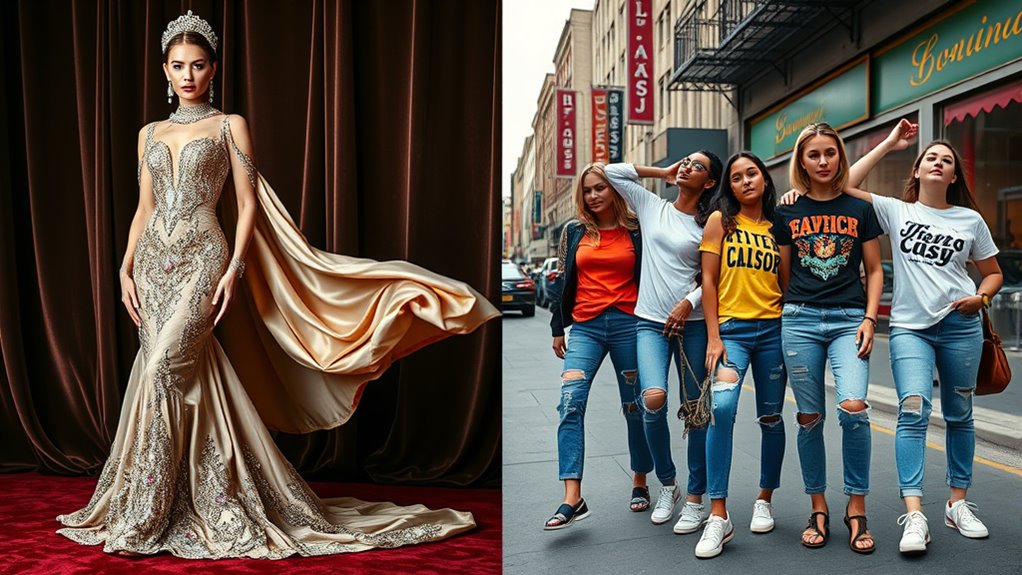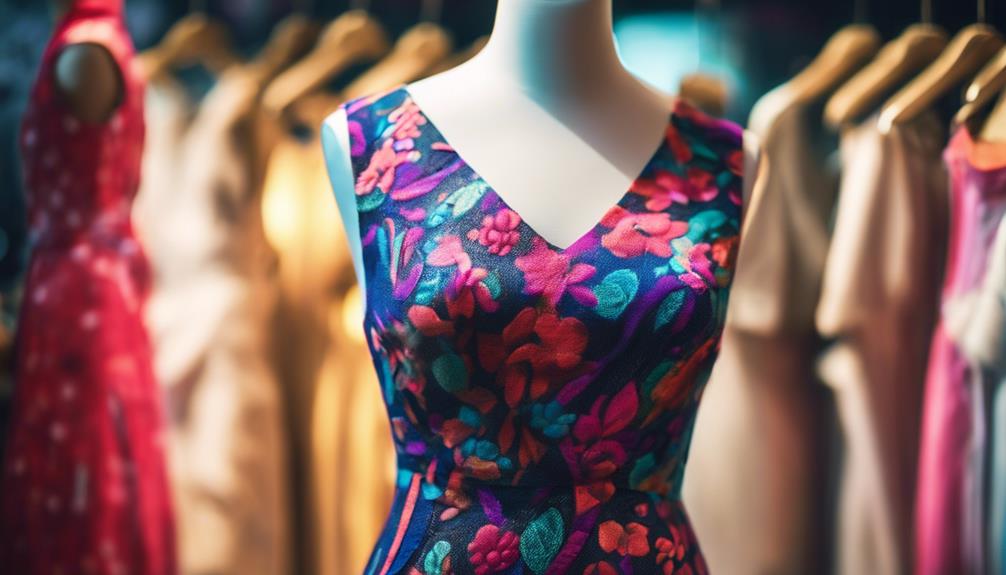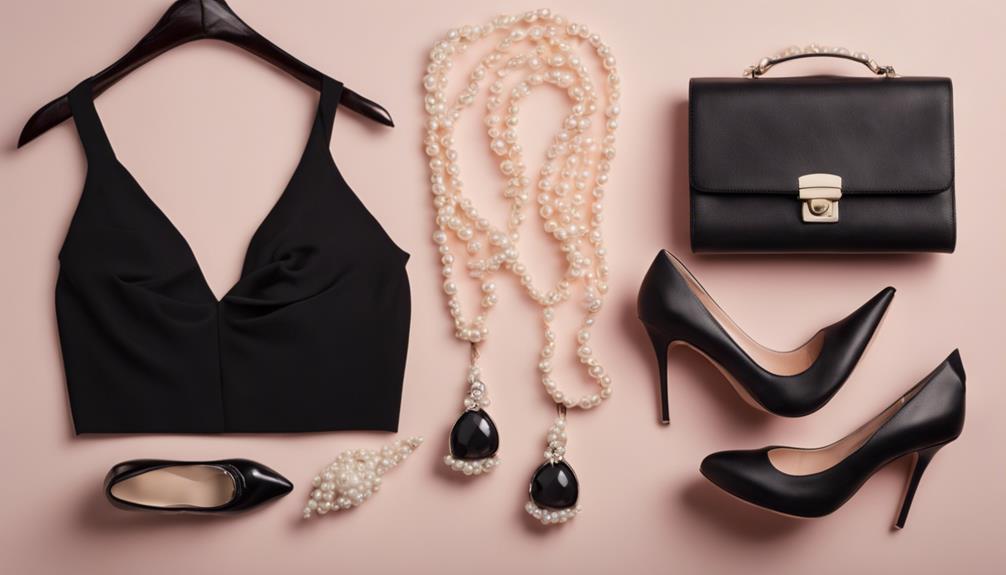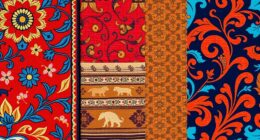High fashion focuses on timeless, custom-designed pieces made with skilled craftsmanship and sustainable materials, often released seasonally and targeting an affluent audience. Fast fashion, on the other hand, emphasizes quick turnaround, trend replication, and affordability, producing new styles weekly through mass manufacturing. While high fashion celebrates artistry and exclusivity, fast fashion responds rapidly to current trends for a broad market. If you want to discover more about what sets these two apart, stay tuned.
Key Takeaways
- High fashion emphasizes timeless, artistic designs with limited collections, while fast fashion rapidly reproduces current trends with frequent releases.
- High fashion focuses on craftsmanship and exclusivity, whereas fast fashion prioritizes affordability and mass accessibility.
- Trends in high fashion evolve slowly through seasonal collections, unlike fast fashion’s quick adaptation to fleeting trends.
- High fashion uses innovative, sustainable materials and techniques, while fast fashion often relies on synthetic, resource-intensive fabrics.
- High fashion’s messaging centers on heritage and artistry, whereas fast fashion emphasizes trendiness and affordability.
Definition and Core Principles

High fashion, also known as haute couture, is characterized by its exclusivity, craftsmanship, and innovation. When you delve into this world, you’ll notice that each piece is carefully handcrafted with attention to detail, often custom-made for individual clients. The core principle is quality over quantity; designers focus on creating timeless, artistic garments rather than mass production. Haute couture pushes the boundaries of design, blending tradition with cutting-edge techniques. It’s about making a statement and setting trends, not just following them. You’ll find that high fashion emphasizes originality, prestige, and artistry, making it a symbol of luxury. Unlike fast fashion, it values craftsmanship and heritage, creating pieces that are meant to last and be treasured. Throughout history, the principles of craftsmanship and innovation have shaped the evolution of high fashion, ensuring its status as a symbol of luxury and artistic mastery. Additionally, many high-fashion houses maintain heritage and tradition, which continue to influence contemporary design. Recognizing the importance of timelessness, high fashion often produces pieces intended to transcend seasonal trends and become enduring icons.
Production Speed and Turnaround Time
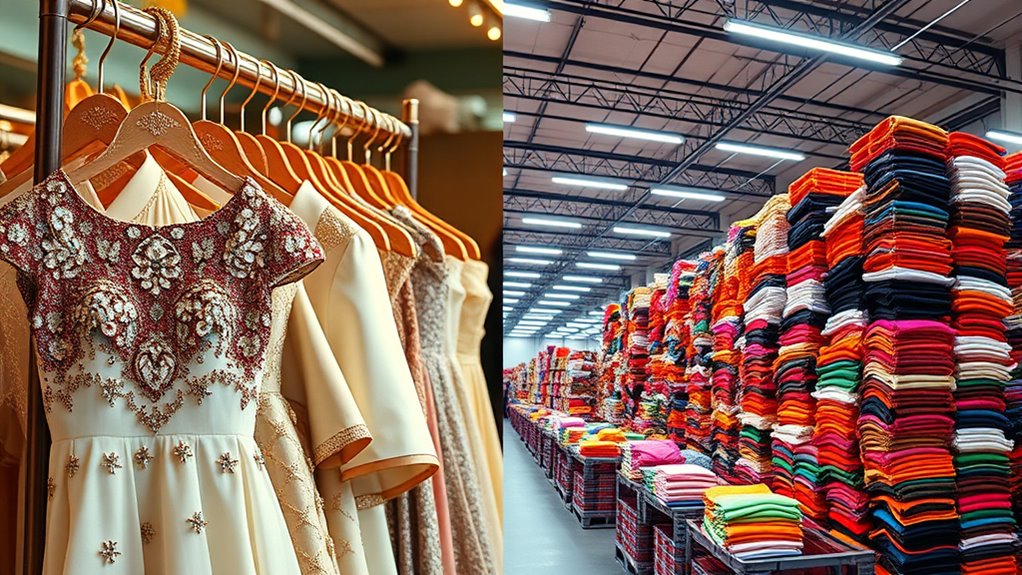
Fast fashion brands prioritize quick manufacturing lead times to get products to market rapidly, often releasing new collections every few weeks. High fashion houses, on the other hand, have longer lead times and fewer collections each year. This difference allows fast fashion to be more flexible in production, quickly adapting to trends, while high fashion focuses on meticulous craftsmanship and exclusivity. Additionally, production speed plays a vital role in how brands respond to changing consumer preferences and market demands.
Manufacturing Lead Times
Manufacturing lead times vary considerably between high fashion and fast fashion, directly impacting how quickly products reach consumers. High fashion brands often take months to produce each collection, focusing on craftsmanship and exclusivity. In contrast, fast fashion brands prioritize speed, turning around new designs within weeks to capitalize on current trends. This difference affects your shopping experience—fast fashion gets you trendy items quickly, while high fashion emphasizes quality and rarity over speed. Additionally, the strategic focus on production efficiency influences the entire supply chain process for each segment. Moreover, the use of innovative materials and technologies impacts the pace at which new collections are developed and delivered. These technological advancements, including advanced manufacturing techniques, can further streamline design and manufacturing processes, affecting lead times across the industry.
Frequency of Collections
The frequency at which collections are released varies greatly between high fashion and fast fashion. High fashion brands typically present new collections seasonally, around twice a year, focusing on craftsmanship and exclusivity. In contrast, fast fashion brands release new collections weekly or even daily, prioritizing rapid turnaround to match trends.
Here’s how the differences play out:
- High fashion focuses on limited, seasonal collections, often taking months to develop.
- Fast fashion churns out frequent, smaller batches, sometimes weekly, to stay on top of trending styles.
- The quick turnaround in fast fashion allows you to access the latest looks almost instantly, while high fashion maintains a more curated, less frequent schedule.
Your shopping habits are shaped by these differing release cycles.
Production Flexibility
While high fashion brands typically take months to produce each collection, fast fashion brands prioritize speed and agility, often turning products around in a matter of days or weeks. This quick turnaround allows fast fashion retailers to respond rapidly to emerging trends and consumer preferences. You’ll find that they use flexible manufacturing processes, often working with suppliers who can adapt designs quickly and scale production on short notice. This flexibility lets them introduce new styles frequently, keeping shelves fresh and customers engaged. In addition, their ability to adjust production schedules swiftly and efficiently is crucial to maintaining their competitive edge. Moreover, their reliance on supply chain agility enables them to manage rapid inventory changes effectively. Their use of advanced technology and data analytics further enhances their capacity to forecast trends and optimize production timing. The integration of real-time data allows fast fashion brands to predict consumer demands more accurately, ensuring they stay ahead of the market. In contrast, high fashion emphasizes meticulous craftsmanship and limited runs, which slows down production. Your ability to swiftly adapt and produce new designs gives fast fashion a significant advantage in staying current and meeting fast-changing demands.
Quality and Craftsmanship
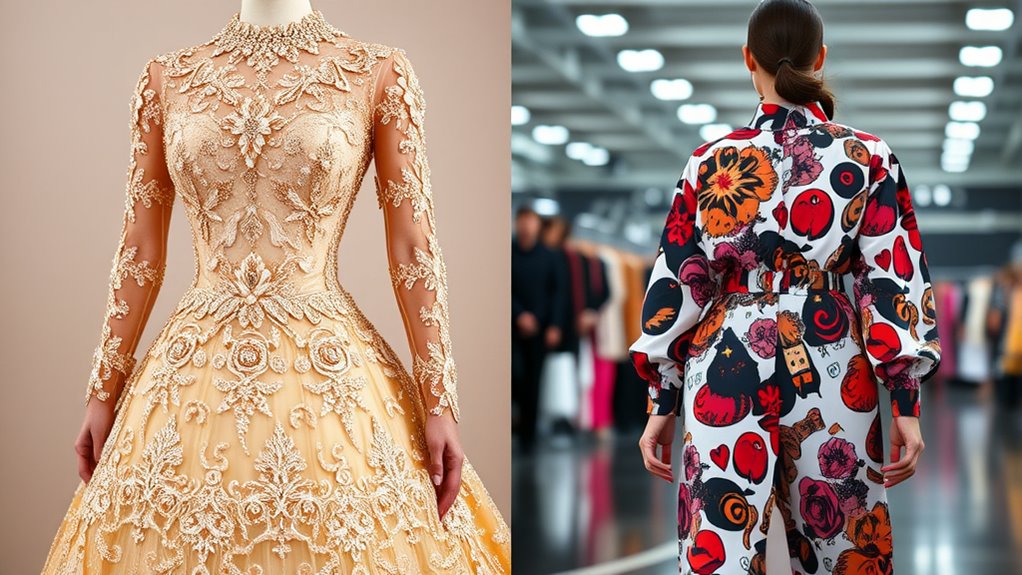
When it comes to quality and craftsmanship, high fashion brands often prioritize meticulous attention to detail and exceptional materials, ensuring each piece is built to last. They focus on hand-stitching, precise tailoring, and sourcing premium fabrics that elevate the final product. This dedication results in garments that withstand wear and maintain their appearance over time. Here are key aspects that set high fashion apart:
- Handcrafted Details – Skilled artisans add intricate finishing touches.
- Premium Materials – Only the finest fabrics and materials are used.
- Durability and Longevity – Designed to last, not just for a season.
Price Points and Accessibility
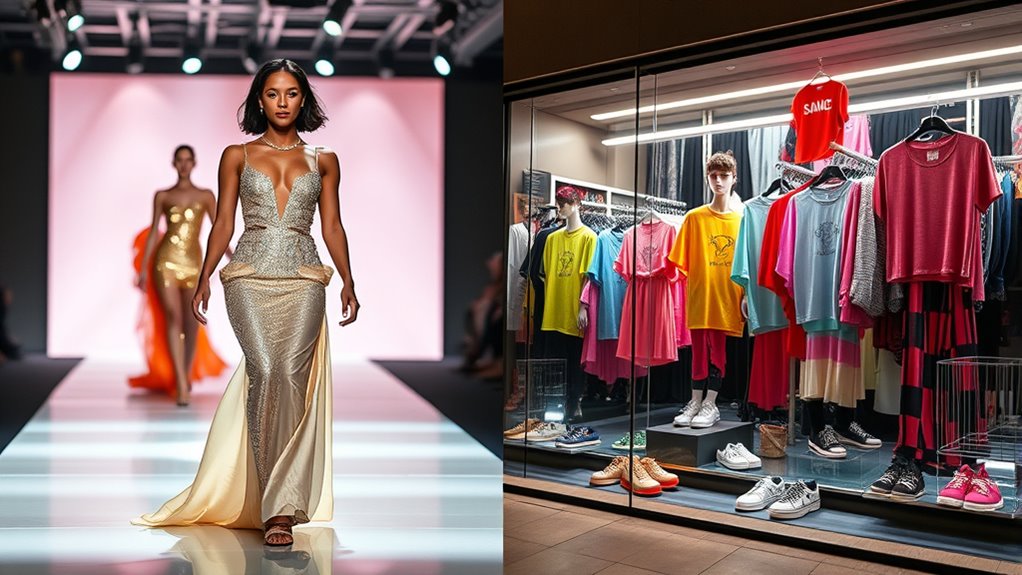
High fashion items often come with lofty price tags that reflect their exclusivity, craftsmanship, and designer branding. You’ll find that these pieces are priced well above what most can afford, making them accessible mainly to the wealthy or dedicated collectors. Limited availability and high production costs drive up prices, which means you need a substantial budget to participate. In contrast, fast fashion offers trendy styles at a fraction of the cost, making it easy for you to stay current without breaking the bank. Accessibility is much higher here: you can find fast fashion brands in malls, online, and even in small towns. While high fashion remains exclusive, fast fashion’s affordability and widespread availability make trendy clothing accessible to nearly everyone. Additionally, the cost of production for fast fashion allows brands to quickly replicate high-end styles and keep prices low. This rapid style turnover ensures that consumers constantly have new options without a significant financial commitment. The ability to quickly adapt to changing trends is supported by the refrigeration cycle, which helps in maintaining efficient manufacturing processes and storage conditions necessary for fast fashion supply chains. Moreover, innovations such as sustainable materials are increasingly being integrated into fast fashion to meet consumer demand for ethical practices. Another factor contributing to fast fashion’s rapid response is the supply chain efficiency, which minimizes delays from design to retail.
Design Approach and Creativity
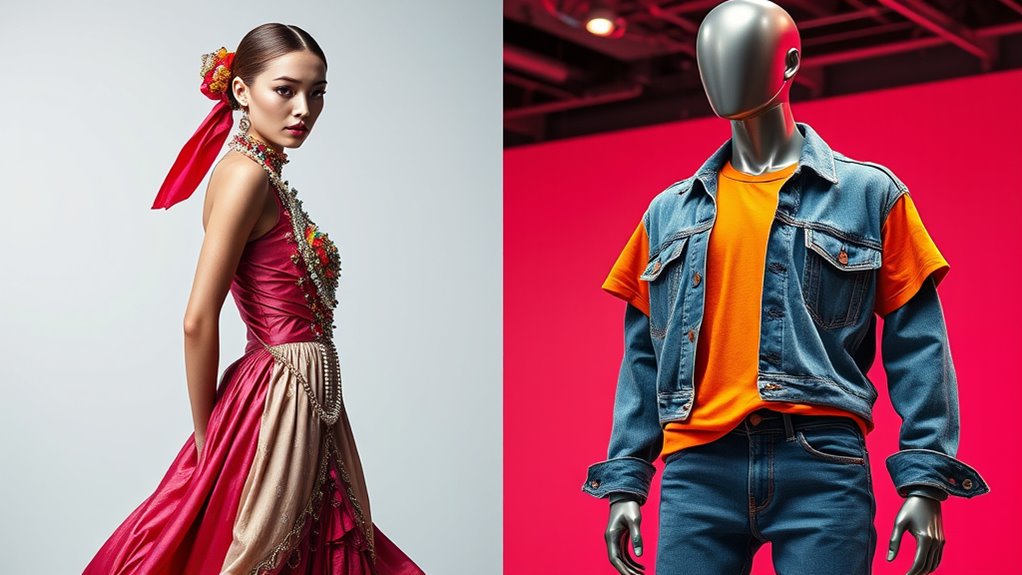
Your perspective on design approach reveals how high fashion pushes boundaries with artistic vision and innovation, while fast fashion often emphasizes practicality. Constraints in production lead fast fashion to prioritize efficiency over creativity, whereas high fashion embraces experimentation. Understanding these differences helps clarify how each approach shapes style and inspiration. Incorporating creative problem-solving techniques from design thinking can further enhance innovative approaches in fashion design. Additionally, the influence of consumer demand for rapid, affordable clothing impacts design choices and limits experimentation in fast fashion. Recognizing the role of self-awareness in design can foster more thoughtful and meaningful fashion creations. Moreover, considering drivetrain components such as gears and tires highlights how specific technical constraints influence performance and innovation in cycling, paralleling how constraints in fashion can shape creative outcomes.
Artistic Vision and Innovation
Artistic vision and innovation serve as the heartbeat of fashion, shaping how designers translate their creative ideas into tangible designs. Your ability to push boundaries and experiment fuels the evolution of style, whether in high fashion or fast fashion. High fashion designers often prioritize originality, using craftsmanship and unique concepts to set trends. In contrast, fast fashion brands aim to quickly adapt popular styles to meet consumer demand. To stand out, you might focus on: 1. Developing signature aesthetics that reflect your artistic voice. 2. Incorporating unconventional materials or techniques to surprise your audience. 3. Embracing new technology, like 3D printing or digital design, to accelerate creative processes. Your innovative approach determines whether your designs become timeless masterpieces or fleeting trends, making artistic vision essential to fashion’s ever-changing landscape. Additionally, paying attention to craftsmanship and materials can elevate your designs, giving them authenticity and durability that resonate with consumers seeking quality and longevity. Incorporating market trends through strategic research can also help your creative vision align with consumer preferences while maintaining originality. Moreover, understanding cultural intelligence can enrich your design process by integrating diverse cultural influences, fostering innovation and broader appeal. For instance, exploring sustainable practices can further enhance your brand’s relevance in today’s eco-conscious market.
Constraints and Practicality
Constraints and practicality often shape how designers approach their work, forcing you to balance creativity with real-world limitations. In high fashion, you might push boundaries but still face constraints like fabric availability and production costs. Fast fashion, on the other hand, emphasizes efficiency and affordability, limiting your design choices to what’s quickly manufacturable. These restrictions influence your creativity, guiding you toward feasible ideas. Consider the following factors:
| Constraint | Impact |
|---|---|
| Fabric availability | Limits material choices |
| Production speed | Restricts complex designs |
| Budget | Affects quality and detail |
| Market trends | Dictates styles to prioritize sales |
| Sustainability | Imposes eco-friendly considerations |
Understanding these boundaries helps you craft designs that are not only innovative but also practical. Additionally, aligning your designs with content quality and topical authority ensures they resonate well with your target audience.
Sustainability and Environmental Impact
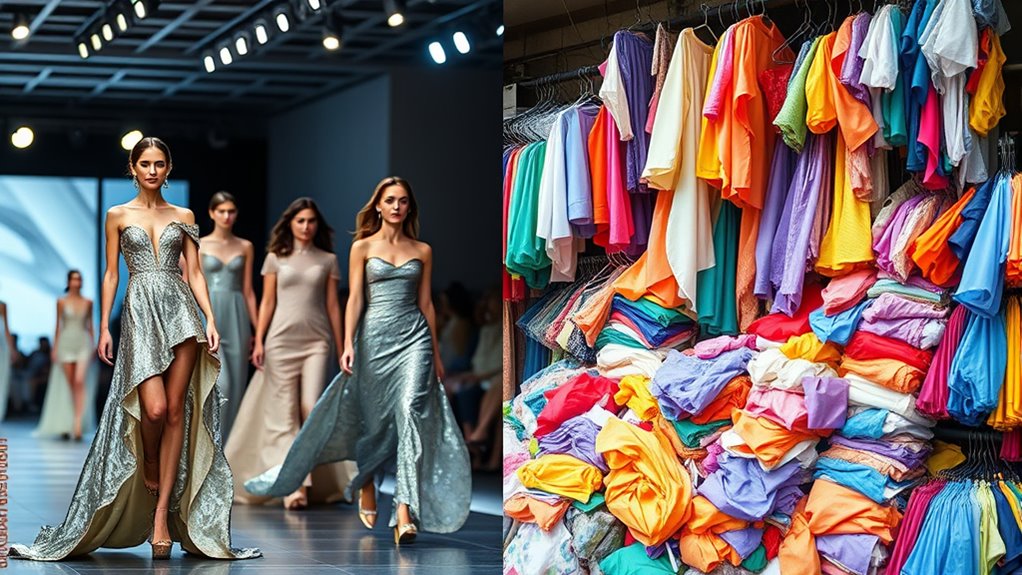
While high fashion often emphasizes craftsmanship and timeless quality, fast fashion prioritizes quick turnover and low costs, which profoundly impacts the environment. Fast fashion produces massive waste, with discarded garments ending up in landfills or polluting waterways. It also consumes vast amounts of water and energy during production. As a consumer, your choices matter:
- Fast fashion’s reliance on synthetic fibers releases microplastics into oceans, harming marine life.
- High fashion’s sustainable practices, like using eco-friendly materials, reduce environmental harm.
- Fast fashion’s quick cycle encourages overproduction, leading to unnecessary resource depletion.
Consumer Demographics and Market Reach

Have you ever wondered who shops high fashion versus fast fashion? High fashion tends to attract a niche audience—wealthy individuals, fashion insiders, and trendsetters willing to invest in exclusive pieces. These consumers often seek unique, high-quality garments that reflect status and craftsmanship. On the other hand, fast fashion appeals to a broader demographic—young adults, students, and budget-conscious shoppers looking for trendy styles at affordable prices. Fast fashion brands reach mass markets through extensive retail and online platforms, making trendy clothing accessible worldwide. While high fashion consumers often shop in designer boutiques or exclusive events, fast fashion buyers frequent retail chains or online shops. This difference in demographics and market reach shapes how each industry operates and influences consumer behavior.
Trends Lifecycle and Longevity

High fashion trends often have a shorter lifecycle, driven by the desire for exclusivity and innovation, which causes them to evolve quickly and frequently. Designers release new collections seasonally, making trends feel fresh but fleeting. Fast fashion, on the other hand, extends trend longevity by rapidly copying high-end styles, so you can wear the look longer. To understand trend lifespan:
- High fashion cycles last around 6 months, with new collections each season.
- Fast fashion updates styles weekly, keeping trends alive for a few months.
- Classic styles from high fashion tend to return after years, while fast fashion trends fade quickly.
Knowing this, you grasp why high fashion feels exclusive and temporary, whereas fast fashion offers more immediate, longer-lasting options.
Brand Identity and Marketing Strategies
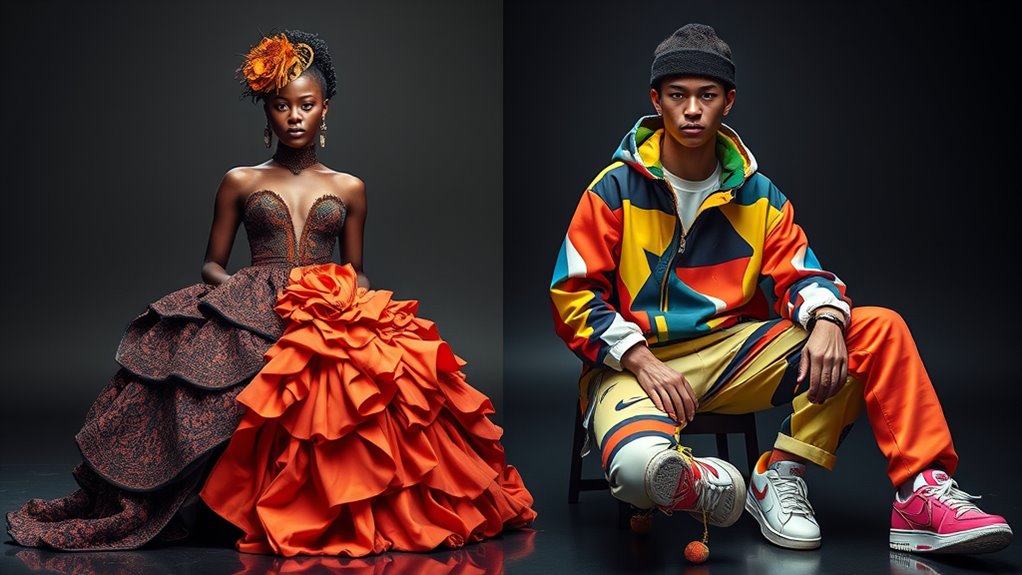
Your brand messaging sets the tone for how customers perceive your style and values. You’ll choose marketing channels that best reach your target audience, whether through social media, influencers, or traditional ads. Maintaining consistency in your identity helps build trust and recognition across all platforms.
Brand Messaging Approaches
Brand messaging approaches differ markedly between high fashion and fast fashion labels, shaping how they communicate their values and appeal to consumers. High fashion brands focus on exclusivity, craftsmanship, and timeless elegance. They often use sophisticated storytelling that emphasizes heritage and artistry, attracting a niche audience. Fast fashion brands, however, prioritize affordability, trendiness, and quick turnover. They craft messages around fast-paced lifestyles, accessibility, and the latest styles. To stand out, fast fashion labels often use bold, eye-catching campaigns that evoke urgency and excitement. Here are three key differences in their messaging strategies:
- *High fashion emphasizes heritage and craftsmanship to build prestige.*
- *Fast fashion highlights affordability and trend responsiveness to appeal to mass markets.*
- *Fast fashion uses vibrant, urgent messaging to drive impulse purchases.*
Marketing Channel Preferences
Marketing channels are chosen strategically to reinforce each brand’s identity and reach their target audiences effectively. High fashion brands often prioritize exclusive channels like runway shows, luxury boutiques, and select high-end magazines to emphasize prestige and craftsmanship. They focus on creating an aura of exclusivity that appeals to affluent consumers. Conversely, fast fashion brands leverage widespread platforms such as social media, online marketplaces, and fast-paced advertising campaigns to maximize visibility and accessibility. They aim to engage a broad audience quickly and frequently update their offerings to stay on-trend. Both approaches reflect their core values—luxury and rarity versus speed and affordability—by selecting channels that resonate with their respective audiences. Your choice of marketing channels directly shapes how consumers perceive and connect with each brand.
Identity Consistency Strategies
Maintaining a consistent identity across all marketing efforts is crucial for high fashion and fast fashion brands, but each approaches this goal differently to reinforce their core values. High fashion brands focus on exclusivity, craftsmanship, and timeless elegance, using refined visuals and storytelling. Fast fashion brands emphasize affordability, trendiness, and accessibility, often leveraging social media and influencer collaborations. To effectively communicate their identities, they employ distinct strategies:
- Consistent visual branding, like logos and color schemes, across all platforms.
- Clear messaging that highlights their unique value propositions.
- Engaging storytelling that resonates with their target audience’s lifestyle and aspirations.
Influence on Fashion Culture
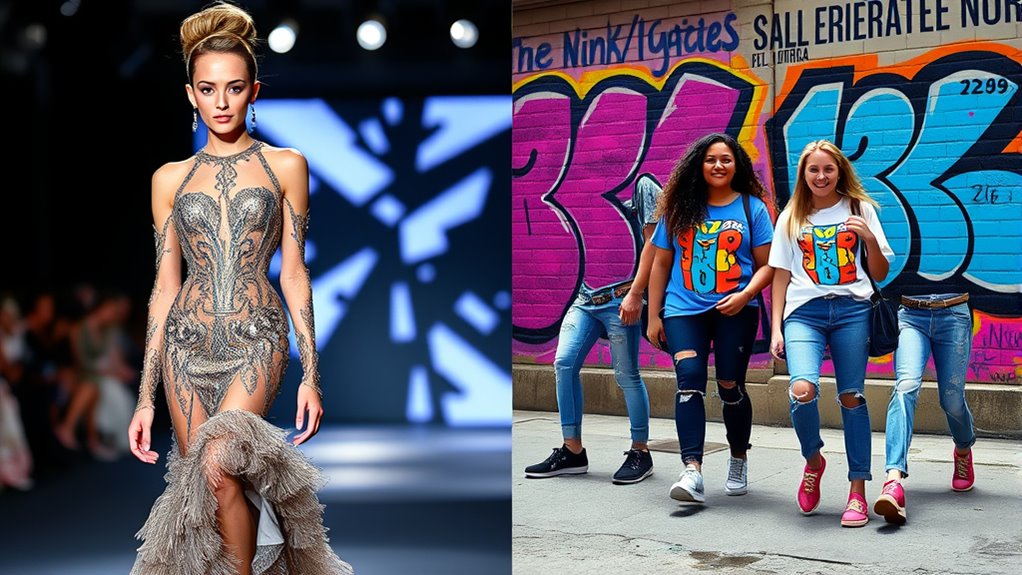
High fashion and fast fashion each shape the way people perceive and engage with style, but they do so in vastly different ways. High fashion influences culture by setting trends that often appear on runways and in editorial shoots, inspiring designers and consumers alike. It cultivates a sense of exclusivity and artistry, shaping what is considered aspirational. Fast fashion, on the other hand, democratizes style by quickly translating runway trends into affordable, accessible pieces. This immediacy encourages more people to experiment with new looks and share them on social media, fueling a culture of instant gratification. Both types of fashion impact cultural conversations—high fashion elevates craftsmanship and tradition, while fast fashion emphasizes novelty and adaptability. Together, they create a dynamic, ever-evolving fashion culture.
Frequently Asked Questions
How Do High Fashion Brands Influence Mainstream Fashion Trends?
You might notice that high fashion brands shape mainstream trends by showcasing innovative designs on runways and in exclusive collections. When these styles hit the runway, they often inspire fast fashion brands to replicate and mass-produce similar looks quickly. This influence trickles down to everyday wear, making high-end runway ideas accessible to the general public. Fundamentally, high fashion sets the creative tone that your favorite stores and brands follow.
What Role Does Celebrity Endorsement Play in Fast Fashion Popularity?
You might think celebrity endorsements are about luxury, but in fast fashion, they’re all about quick hype. When your favorite star wears a trendy piece, it suddenly becomes a must-have, even if it’s cheaply made. Ironically, this instant influence keeps prices low and turnover high, making you buy more often. Celebrities may seem glamorous, but they’re actually fueling a cycle of fleeting trends that keep the fast fashion machine running.
How Do Seasonal Collections Impact Consumer Purchasing Behavior?
Seasonal collections influence your buying habits by creating a sense of urgency and freshness. As new collections arrive each season, you’re more likely to make spontaneous purchases to stay trendy and updated. These collections also guide your expectations, encouraging you to buy the latest styles before they sell out. Ultimately, seasonal collections keep you engaged with constantly changing options, prompting you to shop more frequently and stay aligned with current fashion cycles.
Are There Differences in Sustainability Practices Between High and Fast Fashion?
Think of sustainability practices as a mirror reflecting a brand’s values. You’ll find that high fashion often invests in eco-friendly materials and ethical production, aiming for longevity and quality. In contrast, fast fashion prioritizes quick, inexpensive manufacturing, often at the expense of environmental impact. While some fast fashion brands are making strides, overall, high fashion tends to lead in sustainable efforts, aligning with a longer-term, eco-conscious vision.
How Do Cultural Influences Shape Design Choices in Both Sectors?
Cultural influences profoundly shape design choices by reflecting societal values, traditions, and identity. You notice that in high fashion, designers often draw inspiration from art, history, and diverse cultures, creating innovative and exclusive pieces. In fast fashion, you see trends quickly adapting to popular culture, social movements, and global influences, making styles more accessible. Both sectors use culture to connect with audiences, but they do so in distinct ways that impact their designs.
Conclusion
In the vibrant dance between high fashion and fast fashion, you’re the spotlight shining on different stages. High fashion weaves intricate tapestries of artistry, while fast fashion flashes like a quick spark of trend. Both shape your wardrobe, but it’s up to you to choose whether you’re savoring a timeless masterpiece or riding the fleeting wave of the latest craze. In this kaleidoscope, your style is the brushstroke—bold, fleeting, or enduring.
